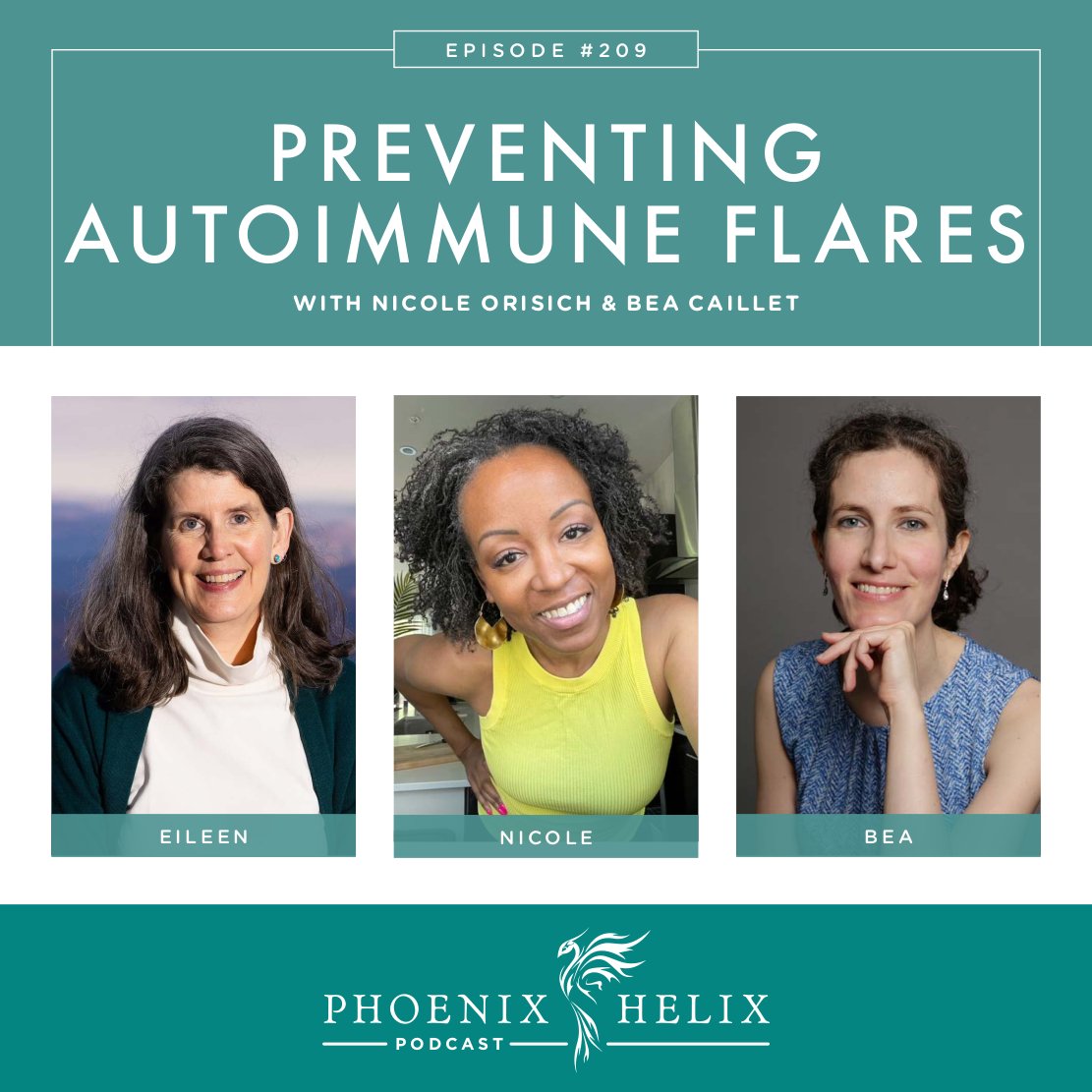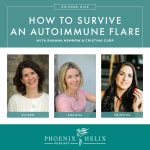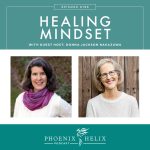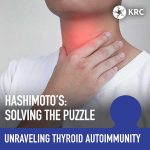
What Are Your Flare Triggers?
With autoimmune disease, flares are part of the experience, and we cannot prevent every single one. However, that doesn’t mean we’re powerless. Discovering our own flare triggers is a powerful piece of self-knowledge. It can help minimize how often we flare and how severe those flares are. That’s the focus of our discussion today. I’ve invited two other autoimmune warriors to join me. We’ll be sharing our personal flare triggers and how we manage them to live our healthiest lives.
Listen to the Show
- Subscribe to my podcast through your favorite podcast app: iTunes, Stitcher, Google, TuneIn, Spotify, Amazon, etc.
- You can also listen to the episode right here through the player below, and if you subscribe to my newsletter you’ll get notified of future episodes.
Podcast: Play in new window | Download
Show Notes
- Intro (0:00)
- Meet Our Guests
- Nicole Orisich has Hashimoto’s thyroiditis and is the woman behind the website, Keep It Cute Kitchen. She’s a Nutritional Therapy Practitioner, a Certified Personal Trainer, and an AIP Certified Coach.
- Bea Caillet has ankylosing spondylitis and is the woman behind the website Go Healthy with Bea. There, she shares gluten-free, paleo, and AIP recipes in both French and English. She is also an integrative nutrition health coach.
- Thank You to Our Podcast Sponsor – Beth Blends (2:48)
- Before we dive into today’s conversation, it’s time to give a shoutout to our podcast sponsor: Beth Blends! They sell grain-free, paleo AIP flour mixes!
- If you’re new to the Paleo Autoimmune Protocol, or you’ve been part of this community a long time, you know that baking can be a challenge. Many ingredients that make conventional baking easy are removed during the elimination phase of the AIP.
- Beth Chen, founder of the company, knows this personally. She turned to the AIP to overcome her own health struggles. Now, her mission is to make life easier for others doing the same. After many experiments in the kitchen, she developed two flour blends that make AIP baking easy! Both flour blends are compliant with the elimination phase of the AIP and packaged in allergen-free facilities. And one of the blends is also coconut-free and cassava-free, for people with additional food sensitivities.
- Dr. Sarah Ballantyne calls them the best flour blends she has ever come across in her 10+ years leading the AIP community. That is high praise!
- In addition to the flour blends, you’ll find all the recipes you need on her website for your next special occasion, including delicious cookies, cakes, muffins, breads, pancakes, waffles, and more.
- Shop here and used the code PHOENIX for 10% off your first order.
- What a Flare Looks Like for Us (4:34)
- Nicole has Hashimoto’s which attacks the thyroid. Her biggest flare symptom is severe fatigue, not the normal fatigue someone feels at the end of the day, but an abnormal level of exhaustion. She’ll end up on the couch feeling like she has run a week-long marathon after minimal activity. That’s how she felt at the end of 2021. In addition to fatigue, flares also bring joint stiffness, brain fog, and depression. Now, she’s in remission, and life is very different. She has mental clarity, access to elevated mood, and while her energy isn’t 100%, she has the energy she needs to accomplish what she wants in a day. She no longer feels like a “sick” person. She feels like a thriving person.
- Bea has ankylosing spondylitis which attacks the joints, typically the spine, neck, ribcage, pelvis, hips, knees, and shoulders, but for Bea it has also impacted her hands, feet, and jaw. Her biggest flare symptom is pain, and movement eases the pain whereas stillness exacerbates it. So, when she is flaring, it’s painful to sit still and pain also wakes her up at night. The worst pain she experienced was in 2006, a year before she was diagnosed. Sometimes she would get only 2 hours of sleep per night, so she was exhausted as well. Some days she could barely walk and felt 90 years old even though she was only 24. She would stay with her parents when she was in too much pain to do daily activities like shopping and cooking. After diagnosis, she struggled to find an effective treatment, so pain continued for the next 4 years until her health stabilized. Depression was part of the experience. Now, many years later, her life is substantially better. She’s not pain-free, but she’s able to manage her pain without medication. She’s happy, independent, and able to work and enjoy a social life. It feels like a completely different life from her rock bottom.
- Eileen has rheumatoid arthritis, which also attacks the joints but typically the smaller joints of the extremities (hands, wrists, and feet), but for Eileen other joints have been impacted as well, including knees, shoulders, ankles, and jaw. The biggest flare symptom is pain and movement makes the pain worse (which is the opposite of Bea’s experience). RA onset in 2012 was Eileen’s rock bottom. She was disabled in just a few months. Like Bea, she felt 90 years old and experienced excruciating pain every day, to a level that she had never experienced before. She would gasp and cry at the intensity. Immobilizing flaring joints was necessary to control the pain. Her sleep was interrupted due to pressure put on flaring joints when lying down. This lead to exhaustion, and her mood was affected as well. Now, 10 years later, her life looks completely different. She has many pain free days, and when pain does come, it’s nowhere near the level it was originally. She has a full, joyful, and active life.
- Although autoimmune diseases differ, many symptoms are similar across diagnoses, including pain, fatigue, sleep interruptions, depression, and feeling overwhelmed by illness. The good news is that in a similar way, diet and lifestyle choices can improve these symptoms across diagnoses as well, as we learn our personal flare triggers. It’s not about perfection, but it is about empowerment.
- Food Triggers (15:47 & 28:21)
- Bea has struggled to identify her food triggers, because her body doesn’t react immediately to a food. Eating something once doesn’t cause a flare, it’s more of a cumulative reaction which makes it difficult to identify. She believes gluten, cow dairy, and raw foods are her biggest triggers. She only learned the raw food piece recently through the Ayurvedic diet. Even after her inflammation lowered, she still had lingering digestive issues after so many years taking NSAIDs. Eliminating raw foods has greatly improved her digestion. (Resource Podcast: Ep. 224 Ayurvedic Medicine.)
- Nicole’s biggest food trigger is black-eyed peas, a favorite food from her childhood. She discovered this one Thanksgiving when she prepared and enjoyed her favorite food but ended up in extreme digestive pain that night. This was the inspiration for her to try an elimination diet, and she chose the AIP. That’s when she discovered she was also sensitive to gluten and dairy. Her functional medicine doctor actually wrote her a prescription to stop eating gluten, and Nicole was furious. She was a self-professed foodie, and her love of her food was very entwined with her identity. Losing her favorite foods felt like her life was being taken away. She ignored the prescription for awhile because she needed time to wrap her head around it. It was important that it felt like her choice and not something forced upon her. She waited until she was ready, and now she has found ways to be a foodie within a healing diet that also supports her health.
- Eileen has had RA for 10 years now, and her food sensitivity was much higher in the beginning when her inflammation was higher. When she first did the AIP back in 2013, nightshades and dairy were her biggest food triggers and she cut them out of her diet for years. Now that her inflammation is lower, she has more food freedom and can enjoy both of those food groups occasionally. But if she has them too often, pain and inflammation will return. So the challenge of a long-term healing diet is finding her food freedom, without going down a slippery slope that leads to inflammation. Sugar is in the same category for Eileen. The occasional paleo treat is fine, but if it’s a daily indulgence, inflammation is the result.
- Resource: Paleo AIP Series – articles, podcasts, FAQ, and books.
- Thank You to Our Podcast Sponsor – Hashimoto’s: Solving the Puzzle (26:30)
- This online course is designed by Dr. Datis Kharrazian, a world-renowned expert in thyroid health. He revolutionized the functional medicine approach to Hashimoto’s by being the first to address the autoimmune component. He’s helped thousands of patients reach remission, and this course is designed to help you achieve that same goal.
- Hashimoto’s is one of the most common autoimmune diseases, affecting 14 million people in the United States alone and millions more worldwide. Unfortunately, it takes an average of 10 years to receive a diagnosis. And many patients are never told their thyroid problem is autoimmune. While thyroid medication can help, it rarely restores health completely. This course gives you the tools to reclaim health and vitality again.
- The online video lessons are divided into 14 modules, and teach you how to:
- Order the right lab tests.
- Know which thyroid hormone medication is best for you.
- Find your unique dietary, lifestyle, chemical, and pathogen triggers.
- Customize a Hashimoto’s diet.
- And learn the best supplements to take for your unique circumstances.
- Dr. Kharrazian is offering my listeners a special discount. Save $100 with the code PHOENIX. That’s a 30% discount off the course! He also has free 1-hour webinar where you can sample his teaching style. Learn more at Drknews.com/phoenix.
- Stress Triggers (32:07)
- Nicole hasn’t noticed that stress triggers autoimmune flares for her, but she definitely noticed that autoimmune disease triggered stress. The mindset technique that made the biggest difference for her was reframing. At first, autoimmune disease made her feel like her life was over. In time, she transformed her perspective into seeing autoimmune disease as an opportunity for next-level self-care. The changes she’s made in support of her health have actually made her life better. It’s the opposite of her life being over.
- For Bea, stress is her biggest flare trigger. Unlike food that has a slow response, stress has an instant reaction on her body. She developed autoimmune disease at the start of a high-stress career, and now, 16 years later, stress remains a big trigger. She does have some favorite relaxation techniques (Epsom baths, hypnosis, and gentle exercise), but she has also set up her life to reduce stress as much as possible. She stopped watching the news, avoids violent movies and books, and takes breaks from stressful people. She also changed to a less stressful career. Lastly, she realized that low self-confidence was causing a lot of stress, so that’s the focus of her personal growth right now.
- For Eileen, stress is a flare trigger as well, but it tends to be cumulative rather than instant. However, mind-body techniques have been part of Eileen’s health journey since the beginning to help her navigate the challenges of life with autoimmune disease. Eileen really values listening to her body’s messages, and she knows how stress, tension, and anxiety feel in her body, and she also knows how to reduce that stress in the moment (and the inflammation it triggers). Simple techniques include deep breathing, a short meditation, or going for a walk. But like Bea and Nicole, getting to the root of stress has also been important, and questioning negative thoughts has had the biggest impact. Techniques that help her do that are journaling and Byron Katie’s The Work.
- Resource: Mindset Series – articles, tutorials, podcasts, and books.
- Thank You to Our Podcast Sponsor – ShopAIP (43:29)
- Today, I’m highlighting their selection of AIP spice blends. This is another way to make the AIP easier and more delicious! Many spices are off-the-table during the elimination phase of the Paleo Autoimmune Protocol, but that doesn’t mean you can’t enjoy flavorful food! Many herbs and spices are still AIP-friendly, and ShopAIP sells some wonderful blends. Primal Palate has a breakfast blend, a super gyro blend, and a garlic & herb. KC Naturals has a seasoned sea salt, an all-purpose meat and veggie seasoning, and a BBQ rub. Truly AIP is a newer company that has a ranch mix, a taco seasoning, and an all-purpose blend. Paleo Powder is another all-purpose herb blend. And Herbamare is the original seasoned salt that also happens to be AIP-friendly.
- ShopAIP is an online store dedicated to the Paleo Autoimmune Protocol. With hundreds of items for the elimination phase of the AIP, and products labeled by reintroduction category as well. You can find protein bars, sauces and condiments, AIP-friendly spices, cooking and baking ingredients, waffle and pancake mix, delicious snacks, and more.
- If you’re a first-time customer, use the code PHOENIX for 10% off your order. Purchase here.
- Lifestyle Triggers (45:08)
- For Bea, lack of sleep and lack of exercise are big flare triggers. Her pain improves with movement, but she also needs to be careful of the type of exercise she chooses because over-exercise can cause flares as well. Walking and biking work best for her. When it comes to sleep, she needs 8 hours a night and a mattress that’s comfortable. Traveling is challenging because the mattresses usually cause pain and disrupt her sleep. For that reason, she usually vacations at her parents’ country home where she has a comfortable bed. Another flare trigger is over-working, or doing too much activity in a day. So, she tries to plan her days accordingly, but she’s not perfect, and sometimes she’ll choose a late night or a busy day, knowing a flare will follow, because she wants the fuller life. She also plans her recovery when she makes that choice. She’s become grateful for her body’s sensitivity because it requires a balanced lifestyle that not only supports her health, but also brings more joy than the high-stress life she had pre-diagnosis. Her life now feels more aligned with her soul.
- Nicole’s biggest lifestyle trigger is physical exertion. She used to own a boutique gym and loved to exercise. When recovering from rock bottom with Hashimoto’s, she tried to go back to the way she exercised before, and that backfired. She learned to slow down and change the way she exercised in a way that gives her access to 100% of the energy she has, without going overboard and causing a flare. Her exercise looks very different now, but it’s a style that supports her health, and that’s very uplifting for her mentally. This slower approach also applies to daily life. If she’s cooking, she’ll stand for part of the time and sit for part of the time. She pictures a battery that’s 15% full, and then prioritizes her day to get 100% of that 15% without going beyond it. And while she did grieve these changes in the beginning, she’s now very happy with her life as it is. Her battery visualization is similar to the “spoon theory” you may have seen on the internet, but instead of mourning the spoons lost, Nicole focuses on celebrating the spoons she has and using them in beautiful ways.
- Eileen’s set up her lifestyle for health, having learned over the past 10 years which behaviors support her health and which behaviors are obstacles to health. That doesn’t mean she lives “perfectly” every day. Sometimes, like Bea, she’ll choose to do something that might result in some inflammation because she decides the experience is worth it and knows how to recover. But overall, she’s developed healthy habits that are simply part of her daily life. She has a fragrance-free home, because fragrance and toxins in general can trigger an autoimmune flare. Sleep is also foundational. She won’t flare after one night’s poor sleep, but if she has a string of nights without enough sleep, inflammation increases. When it comes to exercise, the right kind of movement is important, and it’s all about listening to what her body needs each day, and it will vary. The biggest thing she’s learned over the past 10 years is the power of acceptance and learning to thrive within the life RA has created rather than wishing for a different life. While RA has brought periods of pain and added some limits, it’s also brought strength, resilience, self-confidence, self-knowledge, self-compassion, this podcast, and this new community. It doesn’t mean she hasn’t grieved the losses – that’s important to do as well. But she also celebrates the gifts.
- Resource: Lifestyle Series – articles, podcasts, and tips.
- Flares Are Not Failures (1:03:13)
- The goal of this podcast is always to empower. Discovering and managing our flare triggers is a powerful health practice. Yet, sometimes flares happen anyway because not all flares are within our control. That’s not a failure. That’s being human. Don’t set perfection as your goal. Autoimmune resilience is equal parts empowerment and self-compassion. Instead of judging yourself for flaring, try to love yourself through it and ask yourself what you need.
- Resource: The companion podcast to this one is Ep. 143: How to Survive an Autoimmune Flare. It contains tips to support you through a flare and help you heal more quickly.
- Outro (1:04:51)
- You can keep up with Nicole Orisich through Instagram. She’s a Nutritional Therapy Practitioner, a Certified Personal Trainer, and an AIP Certified Coach. She’s available to work with people 1:1.
- You can keep up with Bea Caillet through her website, Go Healthy with Bea. It’s a bilingual website and available in both French and English. She’s also on social media under the same name. She recently completed her health coach certification and is available to work with French-speaking clients.
- Eileen (your podcast host) is the author of multiple books, written to help people thrive with autoimmune disease. Learn more on the Books Page.
- If you like this podcast, follow or subscribe through your favorite podcast app. You can also subscribe to Eileen’s biweekly newsletter.
- Check out the entire archive of podcast episodes.
You May Also Be Interested In
Spreading the Word
If you like the podcast, please leave a positive review in iTunes. It would mean the world to me, and also helps others find the podcast. Here are some quick instructions using your iPhone:
- If you are already subscribed to my podcast: (1) Click the purple podcast icon. (2) At the bottom of the screen, click Library. (3) At the top of the screen, click Shows. (4) Click the Phoenix Helix podcast image. (5) Scroll down the page, and you’ll see Ratings and Reviews. Scroll down a little bit more and click on Write a Review. This will bring up the review screen. Tap 5 stars (if you love the podcast), and then click in the title box, and it will bring up the keyboard. Enter a title and short review. (6) Click Send in the upper right corner. (7) Thank you! Positive reviews give the podcast a higher search ranking in iTunes, helping people find it and letting them know it’s a quality podcast and worth their time to listen.
- If you haven’t subscribed to my podcast: (1) Click the purple podcast icon. (2) In the lower right corner, click the magnifying class. (3) Type Phoenix Helix in the search box. (4) Click the podcast cover in the Show list. (5) If you’d like to subscribe, click the + sign at the top of the screen. (6) To write a review, scroll down the page, and you’ll see Ratings and Reviews. Scroll down a little bit more and click on Write a Review. This will bring up the review screen. Tap 5 stars (if you love the podcast), and then click in the title box, and it will bring up the keyboard. Enter a title and short review. (7) Click Send in the upper right corner. (8) Thank you! Positive reviews give the podcast a higher search ranking in iTunes, helping people find it and letting them know it’s a quality podcast and worth their time to listen.







